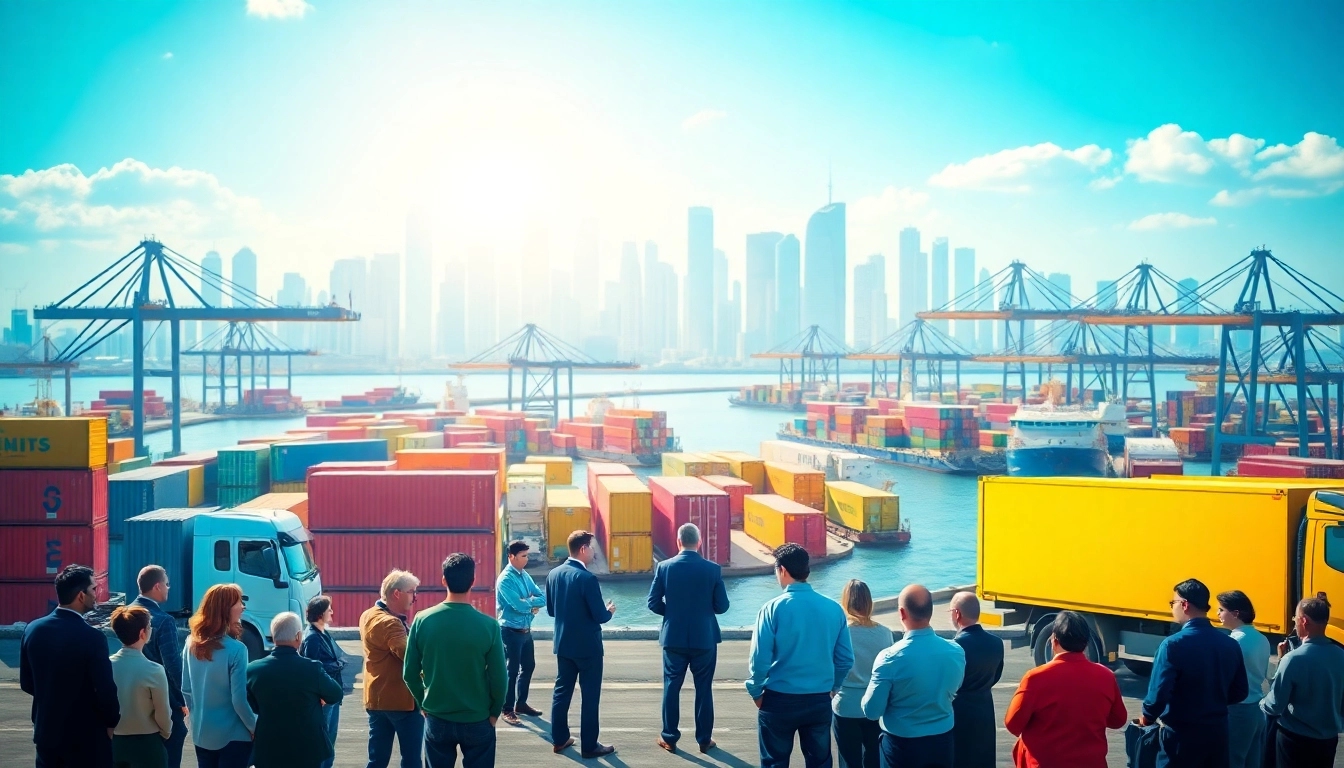
The Impact of Export Tariffs on Global Trade: Insights and Strategies
Understanding Export Tariffs
What Are Export Tariffs?
Export tariffs, also known as export duties, are fees imposed by governments on goods that are sold or shipped out of a country. Unlike import tariffs, which are levied on incoming goods, export tariffs are designed to generate revenue for the government while potentially controlling the flow of certain goods out of the country. This tax is typically a percentage of the value of the exported goods and can vary based on the type of goods being exported, the destination, and the current trade policies in effect. For instance, raw materials might face higher export tariffs to encourage domestic consumption, while high-value finished goods may have lower tariffs to promote competitiveness internationally.
These tariffs directly impact the costs incurred by exporters and can play a significant role in determining market prices. Understanding export tariffs is crucial for businesses involved in international trade, as these fees can influence profitability, pricing strategies, and overall market accessibility. Moreover, it is essential to navigate the complexities of these tariffs to make informed decisions in an ever-evolving trade landscape.
For further information on managing export tariffs effectively, businesses must delve into the regulatory framework and economic consequences.
Types of Export Tariffs
Export tariffs can be categorized into several types based on their purpose and implementation:
1. Ad Valorem Tariffs: These are based on the value of the goods being exported. A stipulated percentage of the selling price is charged. For example, a 10% ad valorem tariff on a product worth $1,000 would amount to $100.
2. Specific Tariffs: These tariffs are fixed amounts charged per unit of goods exported, regardless of their value. For instance, a specific tariff of $50 per ton on iron ore would remain constant regardless of the ore’s market value.
3. Mixed Tariffs: Some countries employ a combination of ad valorem and specific tariffs, meaning that both a percentage and a fixed rate might apply to certain goods. This structure can help balance revenue collection while addressing market conditions.
4. Export Quotas: While not a tariff in the traditional sense, quotas limit the quantity of a specific good that can be exported. This can create artificial scarcity and increase the market price domestically.
5. Temporary Tariffs: Occasionally, governments implement temporary tariffs during times of economic distress or when attempting to regulate trade imbalances.
Each type of tariff has specific implications for exporters and should be considered during strategic planning and market analysis.
Key Regulations Surrounding Export Tariffs
The regulatory environment governing export tariffs is complex and differs significantly from one country to another. However, there are common facets of this regulatory framework that exporters need to be aware of:
1. Legal Framework: In many countries, including the United States, the Constitution and various federal laws lay the groundwork for tariff regulations. Notably, the U.S. Constitution under Article 1, Section 9 prohibits any export taxes, creating a unique environment where export tariffs are generally not imposed.
2. International Agreements: Many countries are bound by international agreements that affect tariff policies, such as free trade agreements (FTAs) like the North American Free Trade Agreement (NAFTA) or the recent United States-Mexico-Canada Agreement (USMCA). These agreements may include stipulations about tariffs that can influence export decisions.
3. Anti-Dumping and Countervailing Duties: These laws are designed to protect domestic industries from foreign competition that might be pricing goods unfairly low or when government subsidies are involved. Understanding how these duties apply can help exporters avoid unexpected costs associated with their products.
4. Export Control Laws: Particular goods, especially those relating to national security, technology, and sensitive materials, may be subject to stringent export controls. Companies must comply with these regulations to ensure that they do not face penalties.
Understanding the regulatory landscape is essential for exporters to navigate potential pitfalls and maintain compliance in an increasingly global trade system.
The Economic Implications of Export Tariffs
How Export Tariffs Affect Trade Balance
Export tariffs can have profound effects on a country’s trade balance, which is the difference between the value of goods it exports and imports. Economists argue that the imposition of export tariffs can lead to several outcomes:
1. Reduced Exports: When tariffs are applied to certain goods, it raises their prices on the international market. Consequently, foreign buyers may seek alternative suppliers, leading to decreased export volumes for domestic producers.
2. Impact on Trade Relations: Other countries may respond to the imposition of export tariffs with retaliatory measures. This escalation can destabilize trade relations, leading to broader economic repercussions.
3. Increased Domestic Prices: To counteract the lower demand from international customers, domestic producers might increase prices, which can trickle down to consumers and increase the cost of living.
4. Balance of Trade Adjustments: The overall effect of export tariffs on a nation’s trade balance might be negative if the tariffs do not sufficiently increase domestic consumption to offset decreases in export activity.
Understanding these implications helps policymakers craft more informed trade policies, ensuring that tariffs serve their intended purpose without incurring unintended negative consequences for the economy.
Impact on Domestic Industries
Export tariffs can have varying impacts on domestic industries, which can be both positive and negative:
1. Protection for Emerging Industries: For developing sectors, higher export tariffs can provide necessary protection against global competitors, allowing these industries time to mature and achieve stability.
2. Cost Increase for Inputs: Many industries rely on imported goods or raw materials. If export tariffs are imposed on these imports, it can lead to cost increases, impacting the overall competitiveness of domestic industries that utilize these inputs.
3. Innovation Stimulant: In certain cases, export tariffs can lead businesses to innovate, seeking ways to reduce costs or improve efficiencies in response to external competitive pressures.
4. Economic Diversification: Governments may use tariffs as a means of fostering economic diversification by encouraging local production and consumption, thereby reducing reliance on foreign goods.
While export tariffs can provide a buffer for domestic industries, it is crucial that such measures are balanced to prevent any negative long-term effects on innovation, pricing, and international competitiveness.
Global Supply Chains and Export Tariffs
In today’s interconnected economy, global supply chains are highly sensitive to changes in tariff policies. Export tariffs can disrupt these supply chains in the following ways:
1. Increased Cost of Goods: Tariffs can lead to increased costs for exporters, which may impact their pricing strategies or the viability of certain products in international markets.
2. Supply Chain Reevaluation: Companies may need to reevaluate their supply chains, potentially seeking alternative sources for raw materials or components that are less affected by tariffs. This might lead to increased operational complexity.
3. Shifts in Global Trade Patterns: As certain countries impose or adjust tariffs, businesses may opt to shift their operations to countries with more favorable trading conditions, leading to a realignment of global supply networks.
4. Resilience Planning: The potential for tariffs to disrupt global supply chains emphasizes the importance of building resilience into supply chain strategies. This may include diversifying suppliers, increasing inventory, or utilizing trade agreements strategically.
Companies engaged in global trade must proactively assess the impact of export tariffs on their supply chains to mitigate risks and optimize operations.
Navigating Export Tariffs in International Trade
Strategies for Compliance and Cost Management
Successfully navigating export tariffs requires strategic compliance and cost management measures. Here are several recommendations for companies engaged in international trade:
1. Stay Informed on Tariff Changes: Regularly monitor changes in tariff policies and international trade regulations. Utilizing tariff tracking tools and subscribing to trade news can provide actionable insights.
2. Conduct Cost-Benefit Analysis: Before proceeding with exports to certain markets, conduct a thorough cost-benefit analysis factoring in potential tariffs and alternative routes.
3. Work with Customs Brokers: Partnering with experienced customs brokers can streamline compliance processes, ensure adherence to regulations, and reduce the risk of costly delays at customs checkpoints.
4. Implement a Compliance Program: Establish a robust compliance program that includes regular training and updates for staff involved in export operations to minimize inadvertent errors that could lead to penalties.
5. Leverage Duty Drawback Programs: Where available, consider utilizing duty drawback programs that offer refunds on tariffs paid on imported materials incorporated into exported products.
Implementing these strategies can significantly improve a company’s ability to manage the challenges posed by export tariffs while optimizing their international trading capabilities.
Tools for Calculating Export Tariffs
Calculating export tariffs can be a complex undertaking, especially given the variations in rates depending on goods, countries, and trade agreements. Utilizing the following tools can help exporters more accurately assess their potential tariff obligations:
1. Harmonized Tariff Schedule (HTS): This document provides the framework for classifying goods and their corresponding tariff rates. In the United States, the HTS can be accessed through the USITC (United States International Trade Commission) website.
2. Tariff Lookup Tools: Resources such as online tariff calculators allow users to enter the codes of specific products to determine their applicable tariff rates quickly.
3. Trade Compliance Software: Various digital platforms offer comprehensive solutions for managing trade regulations, including tariff calculations, compliance records, and updates on changing regulations.
4. Consult with Trade Experts: Engaging with consultants who specialize in international trade can provide tailored solutions, including accurate tariff projections and strategic advice on navigating complex tariff structures.
Employing these tools can decisively improve accuracy in tariff calculation and overall compliance.
Frequently Asked Questions on Export Tariffs
1. Are export tariffs illegal in the US?
The U.S. Constitution (Article 1, Section 9) prohibits export taxes, meaning generally speaking, export tariffs are not allowed. However, the U.S. government has employed alternative measures to regulate the flow of certain goods.
2. What are the effects of tariffs on exports?
Export tariffs can lead to higher prices for domestic goods, impacting competitiveness in international markets, potentially leading to reduced export volumes and alterations to trade agreements.
3. What are the disadvantages of export tariffs?
While export tariffs can protect domestic industries, they may raise consumer prices, disrupt global trade partnerships, and create market instability, necessitating careful consideration by policymakers.
By addressing these often-asked questions, stakeholders can better grasp the implications of export tariffs within international trade.
Recent Trends in Export Tariffs
Case Studies of Recent Tariff Changes
Examining recent case studies can provide valuable insights into the practical effects of export tariffs. For instance:
– U.S.-China Trade Relations: The trade tensions between the U.S. and China led to various tariffs affecting numerous sectors. For example, tariffs on steel and aluminum led to increased production costs for U.S. manufacturers, prompting some firms to move operations overseas.
– The European Union and Agricultural Exports: The EU has imposed tariffs on specific agricultural exports from countries that do not comply with its agricultural standards. These tariffs have influenced the dynamics of food production and export in various member states, prompting adjustments among local farmers and distributors.
Such case studies illustrate the operational realities of export tariffs and the necessity for anticipating these factors in business strategies.
Comparative Analysis: USA vs. Global Trends
Export tariffs are not unique to the United States; many countries employ them as tools for regulating trade. When analyzing the U.S. approach compared to global trends, several observations arise:
1. Variability in Tariff Levels: The United States has traditionally maintained a relatively low tariff regime, whereas other countries might impose higher rates to protect emerging industries better or manage deficits.
2. Responding to Globalization: As globalization has expanded, many countries have begun to explore tariff reductions, showcasing a collective move towards free trade. However, the U.S. has exhibited a more protectionist stance in recent years, particularly during times of economic distress.
3. Retaliatory Measures: Many countries have responded to U.S. tariffs with their own, leading to a cycle of retaliatory tariffs that complicate international trade agreements. This trend has highlighted the interconnected nature of global trade and the potential for tariffs to disrupt multiple economies.
Such comparisons can inform stakeholders about the broader trade landscape and facilitate strategic adjustments when entering international markets.
Future Projections for Export Tariffs
The future of export tariffs will likely be influenced by several trends, including:
1. Evolving Trade Agreements: As countries continue to negotiate new trade agreements, the landscape for export tariffs will change. Multinational pacts potentially offer reductions or eliminations of tariffs, promoting freer trade flow.
2. Technological Advancements: Automation and digital trade tools may alleviate some tariff-related burdens, helping firms adapt more efficiently to changing regulations and cost structures.
3. Shift Toward Sustainability: As countries prioritize environmental impacts, tariffs may be adjusted to promote sustainable practices, where goods produced with higher carbon footprints face additional export fees.
4. Geopolitical Tensions: Continuing geopolitical tensions will likely lead to more stringent tariff policies as nations prioritize domestic industries against perceived threats from foreign competition.
In summary, businesses must remain agile and adaptable to navigate the evolving world of export tariffs effectively.
Conclusion and Recommendations
Best Practices for Managing Export Tariffs
To effectively manage export tariffs, businesses should consider the following best practices:
1. Thorough Research and Compliance: Develop a dedicated team focused on compliance with tariff regulations and trade agreements. Investing in training and tools to stay informed about legislative changes is essential.
2. Financial Modeling: Utilize financial modeling tools to assess how various export tariffs will impact profit margins, leading to better-informed pricing decisions.
3. Engagement with Trade Associations: Join trade associations related to specific industries to gain access to resources, networking opportunities, and advocacy aimed at influencing tariff policies beneficial to members.
4. Scenario Planning: Implement scenario planning to prepare for potential trade policy shifts or geopolitical events. This can aid in devising contingency strategies that minimize risks associated with changes in export tariffs.
By applying these best practices, organizations can enhance their ability to navigate export tariffs effectively and position themselves for success in international trade.
Exploring Alternatives to Export Tariffs
Given the challenges posed by export tariffs, businesses might consider exploring alternatives to achieve their trade goals:
1. Free Trade Agreements (FTAs): Engaging in FTAs that reduce or eliminate tariffs can broaden market access and enhance competitiveness without adverse tariff implications.
2. Subsidies and Incentives: Governments may provide financial subsidies that can offset the costs associated with tariffs, enabling businesses to thrive while facing fewer barriers.
3. Diversification of Markets: Expanding into diverse markets may mitigate tariff impacts by reducing reliance on single markets heavily affected by tariffs.
4. Trade Remediation Services: Utilizing trade remediation consulting services can help businesses identify strategies and best practices that streamline operations and reduce the financial burden posed by tariffs.
By exploring alternatives, businesses can continue to grow their market presence despite the challenges posed by export tariffs.
Final Thoughts on Trade Strategies
Understanding and managing export tariffs is crucial for businesses engaged in international trade. Export tariffs can significantly influence costs, prices, and overall trade dynamics. The implementation of effective strategies, compliance with regulations, and an adaptable mindset can empower businesses to navigate this landscape successfully.
Going forward, companies should anticipate changes in global trade patterns, cultivate relationships that facilitate access to diverse markets, and continuously evaluate their strategies to align with the evolving international trade environment. In doing so, businesses can enhance their resilience and long-term success in the global marketplace.



